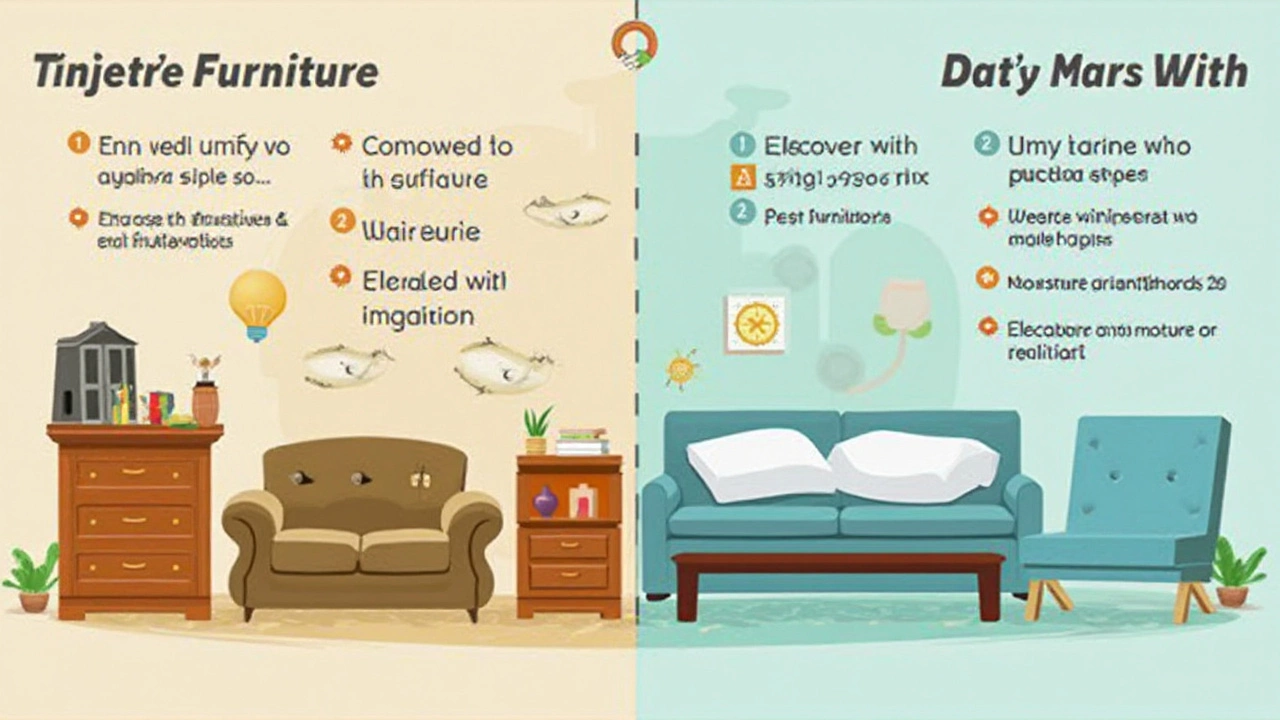Most people use their garage for everything—tools, bikes, and yeah, sometimes even that spare couch or old dresser. But just because there's empty space doesn't mean it's always the best spot for storing furniture, especially if the garage isn’t heated.
Unheated garages go through crazy temperature swings. In summer, they get hot and sticky. In winter, it’s freezing cold. These ups and downs can be rough on all sorts of furniture, whether it’s made from solid wood, particleboard, metal, or fabric.
If you’re wondering if your stuff will survive being out there, you’re not alone. Knowing what could go wrong (like mold, warping, or pests) helps you decide if taking the risk makes sense for your situation—or if you need a better plan.
- What Happens to Furniture in an Unheated Garage?
- How Different Materials React
- Biggest Risks: Weather, Pests, and More
- Tips to Protect Your Furniture
- When Garage Storage Does—and Doesn’t—Make Sense
What Happens to Furniture in an Unheated Garage?
The minute you stash furniture in an unheated garage, you sign up for a lot of unknowns. Garages aren’t designed with comfort in mind, and their temperatures often match the great outdoors. Freezing winter air, summer heatwaves, and shifting humidity all hit your stuff hard.
Let’s break down what typically happens inside an unheated garage:
- Wood furniture tends to warp, crack, or split as its moisture content rises and falls. If you have anything made from solid wood or even pressed wood, those temperature swings can do permanent damage. Once that dresser swells or the veneer peels, there’s no easy fix.
- Metal parts like hinges or table legs attract condensation, which means rust can spread fast. Even powder-coated or painted metals aren’t immune if you leave them in a damp environment for long.
- Upholstered pieces absorb smells, moisture, and dust like a sponge. This often leads to mold and mildew, especially in places with high humidity. Upholstery foam can break down, and you might notice stained or smelly fabric after a season or two.
- Particleboard and MDF swell up or crumble with just a little moisture. Think old Ikea furniture left over from college days—those pieces rarely make it through a single wet winter in the garage.
Here’s a quick look at just how wide garage temps can swing throughout the year:
| Season | Outdoor Temp Range (°F) | Typical Garage Temp (°F) |
|---|---|---|
| Winter | 20 - 40 | 30 - 50 |
| Spring/Fall | 40 - 70 | 45 - 75 |
| Summer | 70 - 95 | 80 - 110 |
And if you live somewhere humid—think the Midwest or the Southeast—the risk of mold multiplies fast after big rain or summer storms.
The biggest takeaway: Storing stuff in an unheated garage means you’re exposing it to every problem that comes with wild temperature and moisture swings. Some things might make it, but others could fall apart before you even drag them out again.
How Different Materials React
Not all furniture handles an unheated garage the same way. The biggest problem? That crazy mix of cold, heat, and humidity. It messes with furniture storage in ways you might not expect.
Wood furniture takes a beating. Real wood expands when it’s damp and shrinks in the cold. This can lead to cracks, warped doors, and even joints coming loose. Ever seen a table get wobbly or a dresser drawer stick? That’s usually why.
Particleboard and MDF are even weaker. They suck up moisture like a sponge and can swell or crumble over time. Once that happens, there’s usually no going back—swollen particleboard just falls apart.
Upholstered furniture is a target for mold and mildew. Any trapped humidity can make cushions smell musty or, worse, start to rot. Stains and discoloration happen pretty fast if the air is damp for long.
Leather furniture isn’t any tougher. Leather dries out and cracks in a cold or super-dry garage. And if the space gets too humid, it can grow mold spots you’ll never fully clean.
Metal pieces like bed frames and tables rust fast if the garage is damp. Even a little water can start that process. Sometimes, you don’t even notice until everything is spotted with orange and feels gritty.
Glass and plastic don’t react as badly to weather changes, but glass can get foggy from condensation. Plastic might get brittle if temperatures drop really low. This is more of a problem for cheaper items.
If you’re thinking of putting expensive or sentimental stuff in the garage, it’s worth stopping and checking what it’s made of first. Different materials call for different storage strategies, especially if you want them in decent shape next year.

Biggest Risks: Weather, Pests, and More
Storing furniture in an unheated garage sounds simple, but there are real risks that can turn your old favorite chair into a pile of regrets. The main troublemakers are moisture, temperature swings, and pests that love snacking on your stuff.
Let’s break it down:
- Moisture and humidity: Extra moisture is public enemy number one for furniture. Most garages aren’t sealed tightly like your house. When air gets humid—think rainy days or muggy summers—wood furniture can absorb that moisture, causing it to swell, warp, or even grow mold. Upholstered pieces pull in musty smells and sometimes mildew, making them feel damp or smelly forever.
- Extreme cold and heat: Garages often drop below freezing in winter or soar past 90°F in summer. All that expanding and contracting puts stress on things like wood joints and glue. Over time, you’ll see cracked finishes or wobbly legs, especially in cheaper furniture.
- Pests: Unheated garages are basically open invitations for mice, ants, termites, and even spiders to move in. Rodents will chew holes through fabric and leave their droppings behind. In some US cities, over 20% of garage owners report rodent damage in stored items. Wood furniture is especially at risk if termites are active in your region.
If you’re a numbers person, here’s how the environment in an unheated garage stacks up year-round:
| Factor | Typical Garage Range | Impact on Furniture |
|---|---|---|
| Temperature | Below 32°F to 100°F+ | Warping, cracking, loose joints |
| Humidity | 40%–90% | Mold, mildew, musty smell, swelling |
| Pests | Common all seasons | Chewing, droppings, stains |
One last thing—garages often lack good air movement, so moisture just sits there, making problems worse. If you’re thinking about furniture storage in a garage, these are the real-life headaches you need to plan for ahead of time.
Tips to Protect Your Furniture
Storing stuff in an unheated garage isn’t automatically a death sentence for your furniture, but you’ve got to be smart about it. Let's get into some straight-up tips you can use right now, whether you’re just stashing a coffee table for a few weeks or planning to keep a whole bedroom set in there through winter.
- Furniture storage starts with basic cleaning. Dust off everything and wipe down surfaces to keep mold and pests away. Vacuum fabric thoroughly and clean any stains—you don’t want these to set in over months.
- Wrap it up. Use breathable covers like moving blankets or old sheets for wood and upholstery. Plastic traps moisture, so skip airtight wraps unless you’re using specialized furniture bags with vents.
- Get it off the ground. Concrete floors attract moisture even if you can’t see it. Use wooden pallets, plastic risers, or even old yoga mats. Keeping items at least two inches off the ground goes a long way against water damage.
- If you’ve got wooden or upholstered pieces, add silica gel packets or small moisture absorbers inside drawers or under cushions to help avoid mold and musty smells.
- Check the weatherstrip on your garage doors. Even a small gap can let in damp air, bugs, or even small critters. Seal cracks with expandable foam or old towels if you don’t want to buy anything special.
- Don’t cram everything together. Space between items helps air flow and keeps mildew at bay. If you stack, always put heavier, sturdier stuff on the bottom and delicate items on top.
- Insurance is your backup plan. Most home policies won’t cover garage-stored belongings unless you add it, so double-check before you trust valuable pieces out there long-term.
| Risk | Quick Fix |
|---|---|
| Moisture (from floor or air) | Use risers and moisture packs |
| Pests (like mice and bugs) | Seal cracks, use traps, check covers for holes |
| Big temperature swings | Wrap with blankets, keep away from garage doors |
| Dust buildup | Cover all surfaces, clean before storing |
Check on your things once a month. Even quick five-minute inspections can help you spot problems before they get out of hand—for example, a warped table leg or the smell of mildew. The effort you put in up front saves way more headache down the road.

When Garage Storage Does—and Doesn’t—Make Sense
There are definitely times when tossing furniture in the garage works out fine, and other times when it’s just asking for trouble. A garage can give you extra space, but it can also expose your stuff to weather, humidity, and critters. Knowing when garage storage is a safe bet boils down to a few key points.
- Furniture storage in an unheated garage can be fine for short periods—think less than three months—especially if you’re dealing with furniture that’s used, not super valuable, and made of tough materials like metal or hard plastic.
- If the garage stays relatively dry (not prone to spring leaks or condensation), storing sturdy shelves, patio furniture, or metal stools isn’t much of a big deal.
- Storing antiques, expensive wooden dressers, or anything upholstered is way riskier. Fluctuating temps and humidity cause wood to split and fabric to grow mold or pick up that musty smell that’s impossible to shake.
- Live in a place with wild seasons? You’ll get humidity spikes, freezing temps, and sometimes, both within a few weeks. This is bad news for anything with wood, leather, or foam padding.
Here’s a glance at how different situations stack up for storing furniture in garages:
| Furniture Type | Okay in Garage? | Best Conditions |
|---|---|---|
| Metal shelving | Yes | Dry, short-term |
| Plastic chairs | Yes | Anytime |
| Solid wood dresser | No | Needs climate control |
| Upholstered couch | No | Only if wrapped, dry, and short-term |
| Particleboard shelves | Maybe | Dry and for a short stretch |
If you’re leaning toward using the garage for storage, it helps to ask yourself: "Will I actually use this piece again? Will I be bummed if it comes out looking (or smelling) worse?" For stuff you want to last—family heirlooms, collector pieces, or anything sentimental—err on the side of indoor or climate-controlled storage. For things like folding tables, outdoor furniture, or cheap shelves meant to get banged up anyway, the garage does the job just fine.

